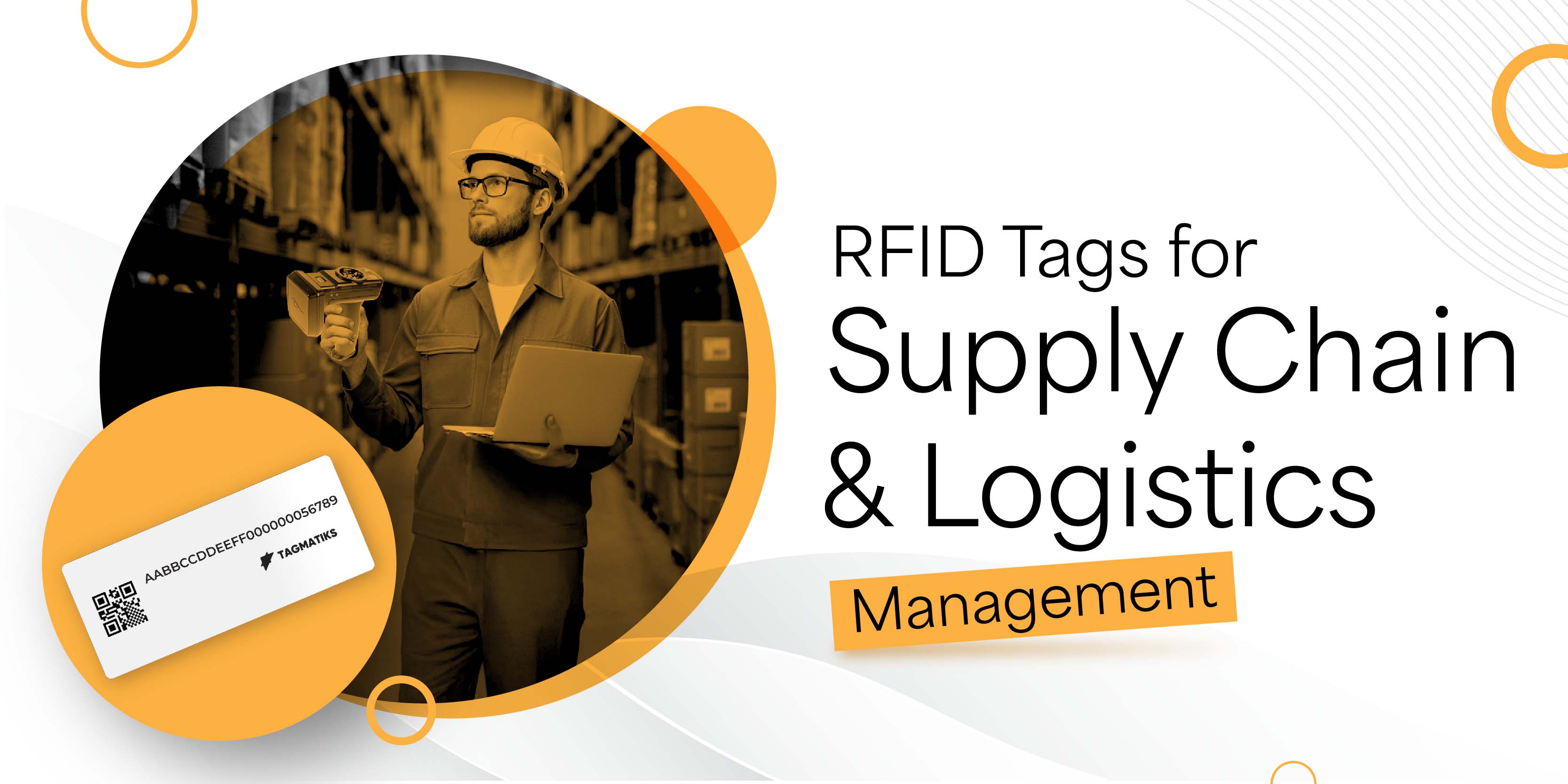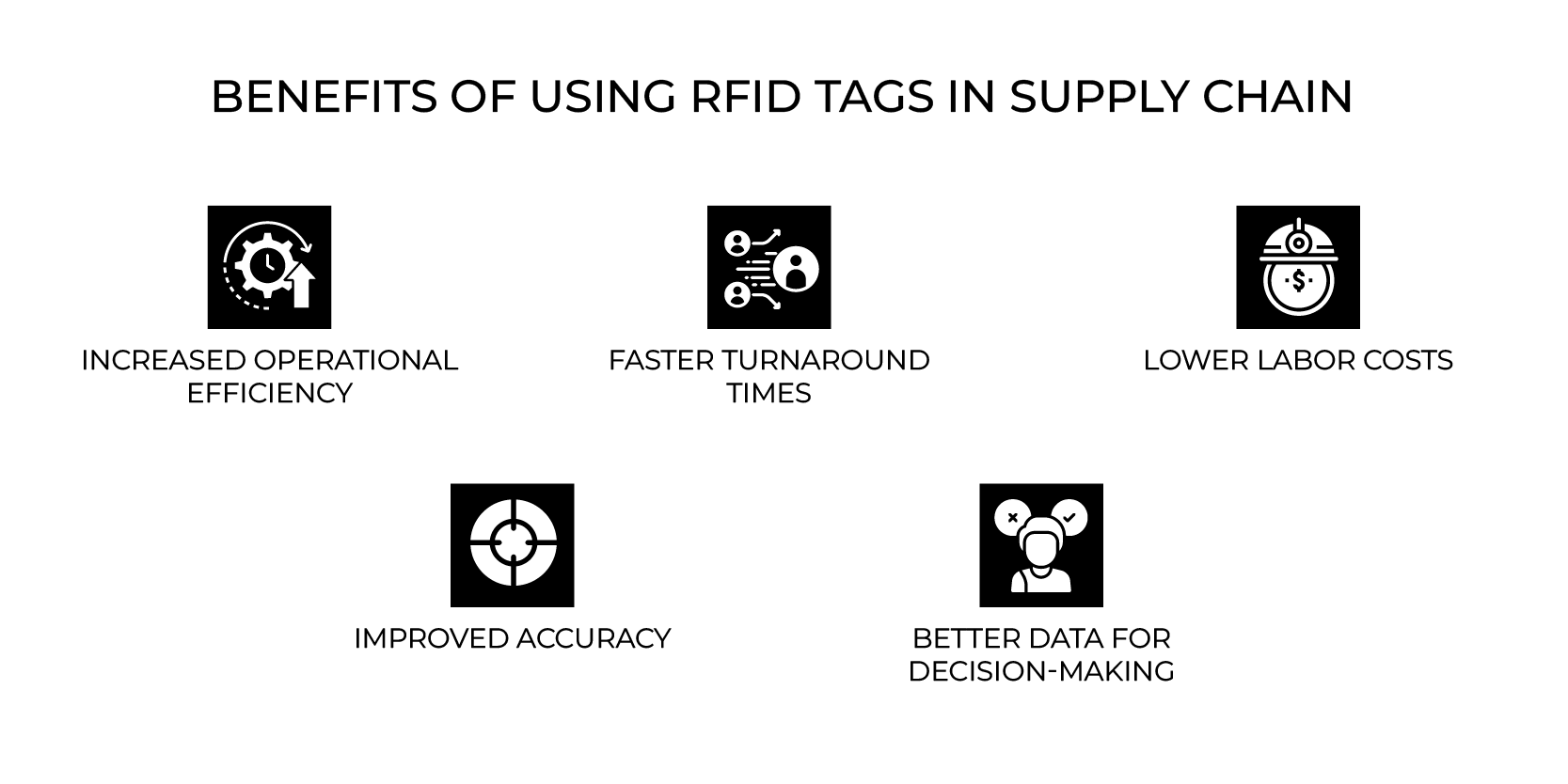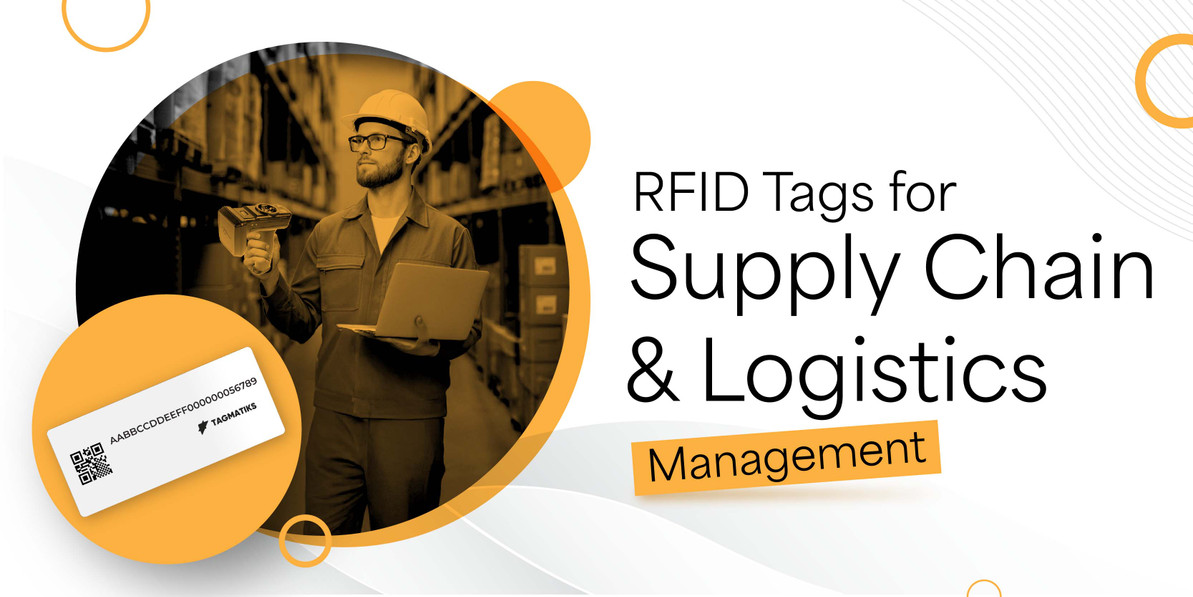RFID Tags for Supply Chain and Logistics Management
Introduction
Radio Frequency Identification is a powerful technology that uses radio waves to automatically identify and track tags attached to objects. These RFID tags store data that can be wirelessly read from a distance—without the need for direct line of sight—making them far more efficient than traditional barcode systems.

In the fast-paced world of supply chain and logistics, RFID has become a critical tool for enhancing visibility, reducing manual errors, and improving operational efficiency. From real-time inventory tracking to streamlined warehouse management, RFID enables businesses to make smarter, data-driven decisions across every stage of the supply chain.
In this blog, we’ll explore what RFID tags are, the challenges they help solve, and how they play a pivotal role in optimizing logistics and supply chain performance.
What Are RFID Tags?
An RFID tag is a small device made up of three main components:
- Chip (or integrated circuit)—Stores unique information related to the tagged item.
- Antenna – Sends the stored data to an RFID reader using radio waves.
- Substrate – A layer that supports and holds the chip and antenna together.
Types of RFID Tags
RFID tags come in several types, with passive RFID tags being the most widely used in supply chain and logistics due to their cost-effectiveness and simplicity. These tags do not have an internal power source; instead, they are powered by the electromagnetic field emitted by an RFID reader. This makes them ideal for high-volume applications like inventory tracking, warehouse management, and shipment verification. While other types, such as active and semi-passive (battery-assisted) RFID tags, exist and are used in more specialized scenarios, passive tags remain the preferred choice for most logistics operations because of their affordability, durability, and scalability.
Challenges in Traditional Supply Chain & Logistics
Before RFID, supply chains often relied on barcode scanning or manual data entry, which introduced several issues:
Manual Data Entry Errors: Relying on manual input often results in typing mistakes, duplication, and inconsistent data, leading to inaccurate records and operational delays.
Poor Inventory Visibility: Traditional tracking methods make it difficult to monitor inventory levels and locations in real time, increasing the chances of stockouts or overstocking.
Misplaced or Lost Goods: Without real-time tracking, items can easily be lost or misplaced within warehouses or during transit, leading to costly delays and reorders.
Inaccurate Shipment Tracking: Limited visibility into shipment status causes delays, miscommunication, and poor customer service due to an inability to provide accurate delivery updates.
Warehouse Delays: Manual check-ins, check-outs, and inventory audits consume significant time and labor, reducing overall efficiency and throughput in warehouse operations.
How RFID Tags Help Optimize Supply Chain & Logistics

Real-Time Inventory Visibility
RFID enables real-time updates as products move through facilities or transit points. This ensures accurate inventory levels, helps avoid overstock or stockouts, and supports better planning and replenishment decisions.
Enhanced Tracking and Traceability
Each RFID tag contains a unique identifier, allowing items to be tracked throughout the supply chain. This helps trace product movement, identify delays, and pinpoint issues with suppliers, carriers, or internal processes.
Automated Data Capture
RFID readers can scan multiple tags simultaneously without requiring line-of-sight. This speeds up check-in/check-out, reduces manual entry, lowers labor costs, and ensures faster processing across warehouses and distribution centers.
Improved Warehouse Management
RFID allows accurate tracking of pallets, bins, and individual items within warehouse zones. This improves location management, speeds up order picking, and reduces time spent searching for misplaced inventory.
Reducing Loss, Theft, and Shrinkage
RFID’s item-level visibility helps detect unauthorized movement or missing items in real time. This reduces inventory shrinkage, deters theft, and enhances overall asset accountability across the supply chain.
RFID Tag Integration in Key Areas of the Supply Chain
Warehousing & Inventory
In warehouses, RFID tags are applied to individual items, pallets, or bins and scanned using handheld or fixed RFID readers. These systems provide real-time inventory visibility, automate stock level monitoring, and track bin locations. As a part of RFID in Logistics & Supply Chain, this implementation improves inventory accuracy, reduces cycle count time, and supports faster replenishment decisions. Businesses can scale operations with better control over stock, location, and movement within warehouse environments.
Transportation & Fleet Management
RFID tags are attached to containers, trucks, and returnable transport items (RTIs) to monitor their movement across shipping points. RFID gate readers at entry and exit points automatically log vehicle movements, enabling better fleet tracking, improved asset utilization, and reduced chances of lost or misrouted goods. This is a crucial aspect of RFID in Logistics & Supply Chain, helping to enhance delivery accuracy and operational transparency across transportation networks.
Retail Distribution & Fulfilment
In distribution centers and retail fulfillment hubs, RFID tags on products enable rapid and accurate order picking through RFID verification. This ensures items are correctly packed and shipped. The technology also speeds up returns processing and improves accuracy in restocking for both e-commerce and omnichannel retail environments. The use of RFID in Retail enables real-time product availability, faster shelf replenishment, and more accurate inventory insights across multiple channels.
Perishable Goods Tracking
RFID tags play a crucial role in tracking perishable goods such as fresh produce, dairy, meat, seafood, and baked items throughout the supply chain. By using sensor-enabled RFID tags, businesses can monitor critical conditions like temperature and humidity in real time, helping maintain freshness and quality during storage and transportation. RFID in Cold Storage ensures perishable goods are kept within safe environmental limits, reducing spoilage, improving shelf life, and ensuring compliance with food safety regulations. This enhanced visibility supports traceability from farm to fork, building consumer trust and improving operational efficiency in food and grocery logistics.
Benefits of Using RFID Tags in Supply Chain

Increased Operational Efficiency: RFID streamlines repetitive tasks like scanning and logging, reducing manual workload and boosting overall process efficiency across warehousing and logistics operations.
Faster Turnaround Times: Automated data capture speeds up receiving, picking, and shipping processes, resulting in quicker order fulfillment and reduced lead times.
Lower Labor Costs: RFID minimizes the need for manual scanning and inventory checks, allowing businesses to optimize workforce allocation and reduce labor expenses.
Improved Accuracy: Real-time tracking and item-level visibility reduce human error, ensuring the right items reach the right place, enhancing customer satisfaction.
Better Data for Decision-Making: RFID provides accurate, real-time data that supports inventory forecasting, supply chain planning, and performance analytics for smarter business strategies.
Conclusion
RFID technology is transforming the way supply chains operate, making them faster, smarter, and more efficient. From real-time inventory tracking to reducing shrinkage, RFID delivers measurable value across the entire logistics ecosystem.
As supply chains grow more complex and customer demands increase, RFID stands out as a strategic tool for achieving agility, accuracy, and scalability.
Recent Posts
-
How RFID Anti-Theft Tags Revolutionize the Retail Industry
Introduction Retail theft and inventory shrinkage are challenges that every store owner faces. Wheth …Dec 22nd 2025 -
RFID Portals in Manufacturing: Tracking Work-in-Progress Efficiently
Introduction Manufacturing thrives on precision and timing. Every part, component, and subassembly m …Dec 15th 2025 -
RF Shielding Explained: Types, Applications, and Benefits
Introduction RF shielding is essential for protecting devices from electromagnetic interference. Thi …Dec 8th 2025




